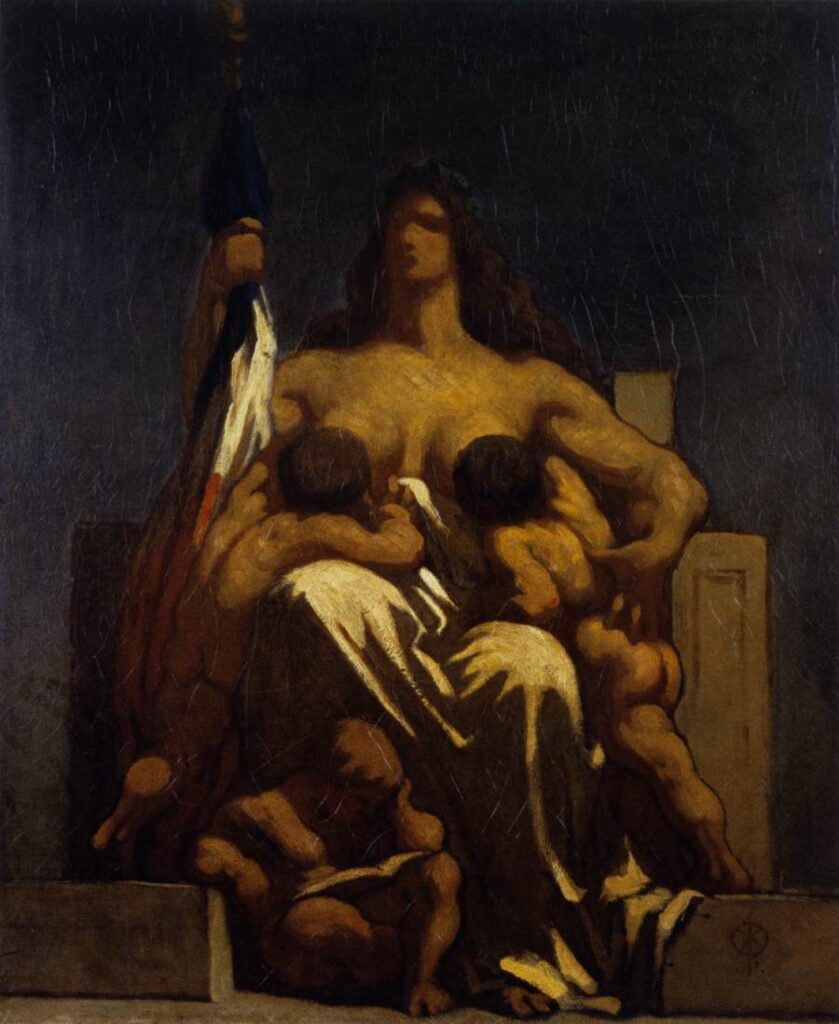
Daumier, La République
Why we Fright
Guillaume Faye, Prelude to War; Chronicle of the Coming Cataclysm, Arktos, 2021, 497pp, reviewed by Leslie Jones
Introduction
According to ‘Archeo-Futurist’ Guillaume Faye, Islamic culture is sui generis. Inherently totalitarian, its driving force is expansionism, the religious obligation to create a global caliphate. Faye agrees with Samuel P Huntington that the ideological conflicts between capitalism and communism have been superseded by a clash between Islamic and non-Islamic societies. The conflict between bourgeoisie and proletariat has given way, in turn, to a new type of class struggle. For the ‘bohemian bourgeoisie’ despise the autochthonous working class and are in an unholy alliance with ‘immigrant colonisers’. Predominantly bourgeois, the left has little contact with immigrants, bar cleaning ladies. ‘Foreigner-free’ schools reinforce its insularity. Only the native working class must endure the insecurity and lawlessness of les banlieues, caused by mass immigration. Yet, for the ‘post Marxist bourgeoisie’, which embraces cosmopolitanism and xenophilia, immigrants are the real victims.
Alain de Benoist maintains that mass immigration has provided cheap labour and a new ‘reserve army of capital’.[i] Faye concurs. One thing, however, remains constant. Material possessions are all important to the bourgeoisie, more important even than ‘the salvation of its own people’.
Le Grand Remplacement
The falling birth rate has long been lamented by patriotic French commentators who accordingly espoused natalism. The distinguished economist Paul Leroy-Beaulieu (1843-1916) furnishes an example. For Faye, likewise, the ‘War with Islamism’ is a ‘war of the womb’. Terrorism is ultimately less of an existential threat than ‘demographical immigrational infiltration’. An unrepentant social Darwinist, he reveres Charles Darwin and Herbert Spencer and thinks that ‘All people are involved in a struggle against each other to ensure their own survival’. In this contest, war is not an aberration and is not to be regretted but is the sine qua non of survival. As Robert Ardrey and Konrad Lorenz have suggested, man, by nature, is an aggressive, tribal and territorial animal.
The forthcoming presidential election in France is viewed in certain circles as a ‘Vote on the Great Replacement’, the theory that indigenous French people are being replaced by non-European peoples. [ii] Sometime Trotskyist Jean-Luc Mélenchon, leader of La France Insoumise, recently stated ‘L’assimilation? Ça n’existe pas. Ce qui existe, c’est la créolisation’.
Marine le Pen (RF) and the yet undeclared candidate Eric Zemmour have highlighted the Islamisation of France and the break-down of law and order in towns and cities with large immigrant populations. As long ago as 1997, Le Monde Diplomatique reported that the city of Roubaix is predominantly Muslim. Marseille, according to Causeur, ‘is already a quarter Muslim’. ‘Every two weeks in France, a mosque is created and a church disappears’, claims Edouard de Lamaze, president of the Observatory of Religious Patrimony.[iii]
Faye contends that the coming race war will involve both ‘street and birth-rate warfare’. He alleges that heavy weaponry is being stashed by Afro-Maghrebian immigrants and that in eleven council estates in France the authorities eschew all interventions, in order not to provoke riots. No-go zones, such as Roubaix are, in effect, lawless zones.
Utopian and Fascistic elements in Faye’s thinking
The author disparages some distinguished intellectuals, past and present. He calls Spinoza’s metaphysics “Brilliant theistic drivel…” He accuses Hegel, Kant, Rousseau and Marx of ‘deifying universalistic egalitarianism’. But Spengler is praised for debunking egalitarianism and for upholding ethnic realities and the notion of peoples. And Nietzsche was a ‘visionary genius’, a throwback to the genuine philosophy and aristocratic values of ancient Greece and Rome. Several more recent thinkers, such as Louis Althusser, Pierre Bourdieu and André Glucksmann have, in his view, hastened the ‘collapse of Europe’s anti-viral defences’. Faye, correctly, condemns the current ‘state of totalitarian monopoly and a complete absence of genuine debate in terms of ideas…’ (as recently exemplified by the hounding of Kathleen Stock).
Paradoxically, for someone who considers Western Philosophy generally ‘disconnected from reality and especially from anthropology and…the laws of life’, there are distinctly utopian elements in Faye’s thought. Each people, in his view, ‘should remain in their own homeland’. He therefore opposes Alain de Benoist’s concept of ethnopluralism, which he considers little better than multiculturalism. Europe must once again become ethnically homogeneous. But how?
In chapter 16, the author, an admirer of the jurist Carl Schmitt, advocates a united Europe under a state ‘endowed with genuine authority’. In a multiracial society, in his view, only a police state can protect freedom and maintain security. Once Muslims have become the majority in France, Faye envisages ‘revolutionary and…belligerent actions’ by armed white militias. ‘We must cleanse our country’, he concludes, of the ‘collaborators’ (‘intellectual filth’) who support mass immigration.
Today, the left supports no platforming and the expulsion of racists from academia.[iv] Fascism, as François Furet observed in Le Passé d’une Illusion, is the mirror image of Communism. And vice versa.
ENDNOTES
[i] QR Autumn 2011, Alain de Benoist, ‘Immigration – the reserve army of capital’
[ii] See ‘France to Vote on the Great Replacement of Western Civilisation’, Giulio Meotti, Migration Watch UK, 22nd October, 2021
[iii] Ibid.,
[iv] See ‘Spart Lad Wanted’, QR, October 8th, 2021
Dr Leslie Jones is Editor of QR











Fascism was not exactly a “mirror image” of communism. It opposed communism, but had a small number of features in common.
The notion of a United Europe has been proposed by people of varied political outlooks and for various, often similar reasons. Compare the actual writings (not the lies or legends) in the 1940s and 1950s by: Denis de Rougemont, Lewis Way, Salvador de Madariaga, Oswald Mosley, Hendrick Brugmans, Franz Josef Strauss, Jean Thiriart, John Bowle, Christopher Dawson, &c. A notable post-war figure was of course Robert Schuman, whose Institute incidentally has published a report on European demographic suicide that sadly corroborates the Great Replacement “theory” which is dismissed as a “racist conspiracy trope”.